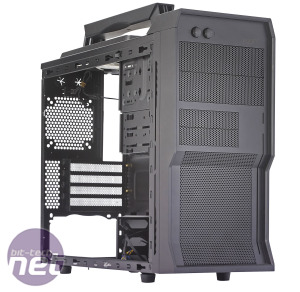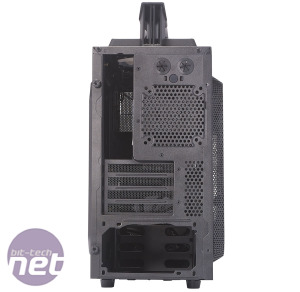
Internals Continued
Located behind the hard disk cage, at the bottom-rear of the case, is the PSU mount. As with most of the cases we see these days, the PSU has its own dedicated intake vent that’s covered by a removable dust filter. Strangely, though, the vent is significantly slimmer than the fan it will be serving, which seems like an oversight.Also of interest is the button that can be found on the rear of the case. We were initially puzzled by its inclusion, but further investigation showed that it was there for toggling the orange lights in the included fans on and off. This is a handy feature, but you’ll need some Jedi-like cable-routeing skills to tidily wire the bundled fans to both the speed controller and light controller.
Building a neat PC inside the Vulcan can also be tricky, given how small it is, but its cable-routeing holes and the extruded right side panel help to make the task interesting rather than impossible. There were a couple of niggles, though, such as the fact that there wasn’t quite enough room to fit the 24-pin ATX power cable from our PSU behind the motherboard tray. There was also no way of routeing the 8-pin EPS12V power cable neatly, and we were forced to run it all the way around the motherboard to reach its socket near the rear I/O plate.
Performance Analysis
The cooling offered by the Vulcan proved to be acceptable, given the case’s size and price. With its fans set to their maximum speed, the CPU reached a delta T of 59˚C, while the GPU reached a delta T of 49˚C. These aren’t spectacular results, but they’re firmly mid-table. More impressive was the ambient internal delta T of our PSU, which was only 8˚C; a result that’s better than that of the more expensive Antec Mini P180 case.Dropping the fans down to their minimum speed understandably saw temperatures inside the case rise. The CPU delta T of 65˚C we saw with the fans at minimum speed was the worst result we’ve seen from a micro-ATX case although, the Vulcan is also significantly cheaper than the other similarly sized cases we’ve seen.
Thankfully, the fans in the Vulcan aren’t too noisy, so you’re more likely to be running them at around 70 per cent speed for everyday use. As predicted, however, the Vulcan allowed a lot of sound to escape from the components inside the PC; the drone of the graphics card cooler was particularly apparent.
Conclusion
The NZXT Vulcan is ideal for a small LAN party PC, thanks to its carry handle, respectable cooling and small size. However, it won't be as appropriate for a day-to-day main desktop PC, as it can be noisy and it’s only got two internal 3.5in drive bays.As a result, whether or not the Vulcan is right for you depends on why you’re building a micro-ATX system. For those just looking for a small system to use every day, the the Silverstone FT03 is likely to be more suitable. Granted it’s more expensive, but it also looks better and runs quieter and cooler than the Vulcan. However, if you want to build a small, powerful LAN PC, and don’t want to spend much more than £50 on the case, the Vulcan is a solid choice.
-
Value18 / 20
-
Design23 / 30
-
Features18 / 20
-
Cooling23 / 30


MSI MPG Velox 100R Chassis Review
October 14 2021 | 15:04













Want to comment? Please log in.